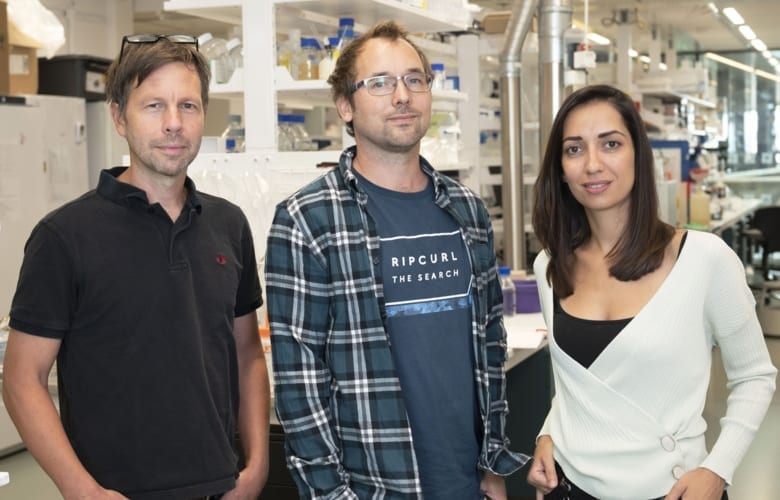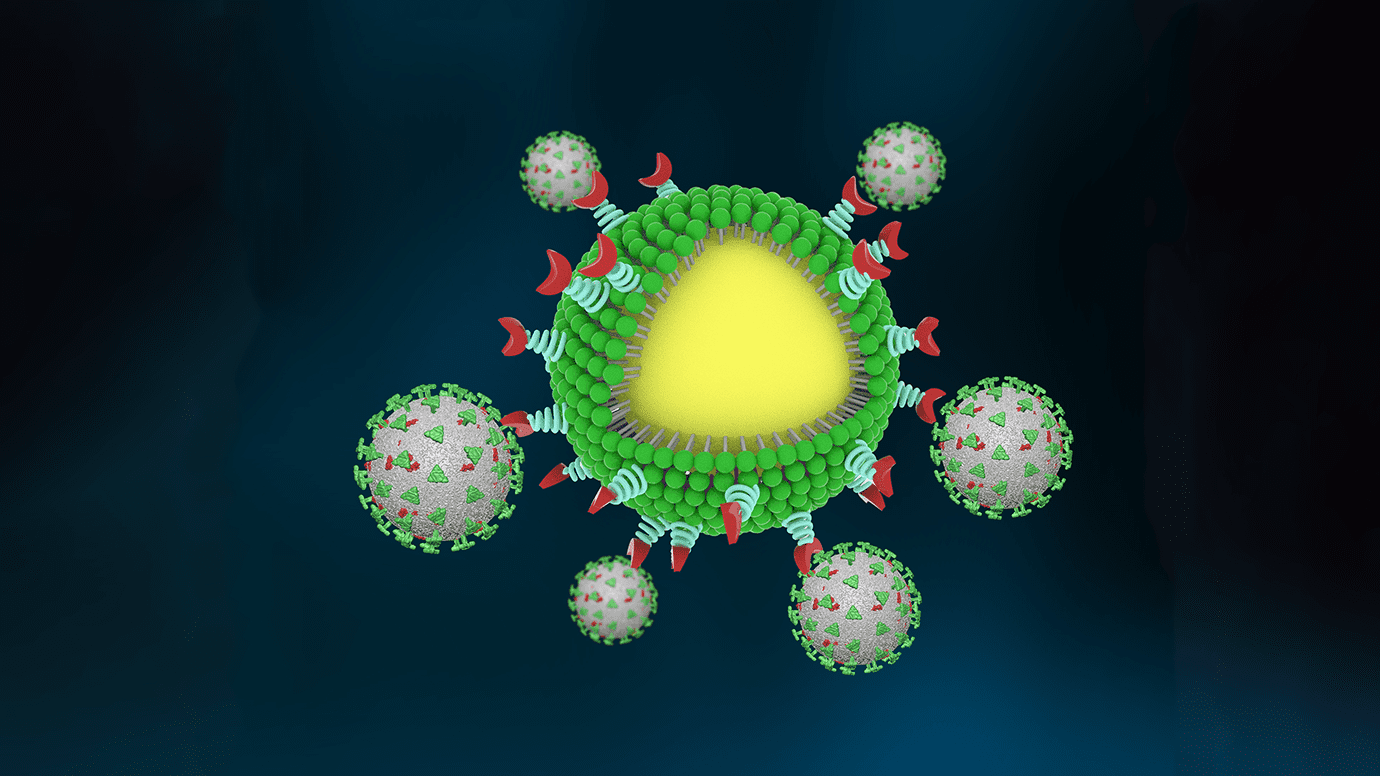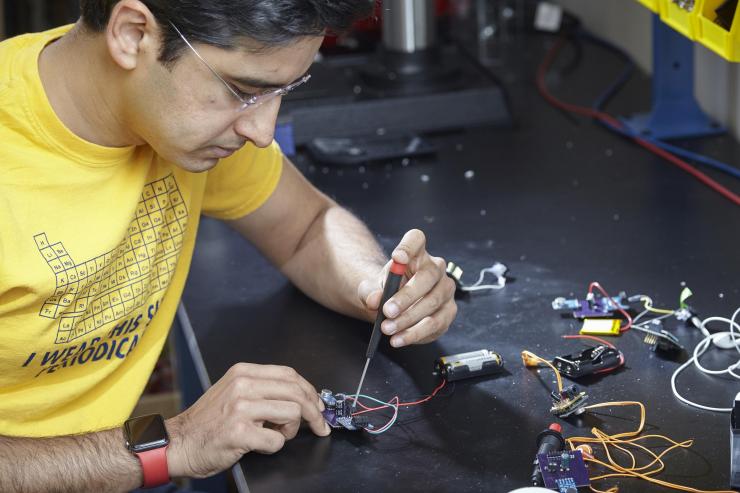
Co-first authors Ioanna Smyrlaki (right) and Martin Ekman (left) and Björn Reinius, principal investigator of the study. Photo: Stefan Zimmerman
Researchers at Karolinska Institutet have developed a method for fast, cheap, yet accurate testing for COVID-19 infection.
The method simplifies and frees the testing from expensive reaction steps, enabling upscaling of the diagnostics. This makes the method particularly attractive for places and situations with limited resources, for repeated testing and for moving resources from expensive diagnostics to other parts of the care chain. The study is published in Nature Communications.
“We started working on the issue of developing a readily available testing method as soon as we saw the developments in Asia and southern Europe, and before the situation reached crisis point in Sweden,” says principal investigator Björn Reinius, research leader at the Department of Medical Biochemistry and Biophysics at Karolinska Institutet. “Our method was effectively finished already by the end of April, and we then made all the data freely available online.”
The spread of the new coronavirus at the end of 2019 in China’s Wuhan region quickly escalated into a global pandemic. The relatively high transmission rate and the large number of asymptomatic infections led to a huge, world-wide need for fast, affordable and effective diagnostic tests that could be performed in clinical as well as non-clinical settings.
Challenges for COVID-19 tests
Established diagnostic tests for COVID-19 are based on the detection of viral RNA in patient samples, such as nasal and throat swabs, from which RNA molecules must then be extracted and purified. RNA purification constitutes a major bottleneck for the testing process, requiring a great deal of equipment and logistics as well as expensive chemical compounds.
Making the current methods simpler without markedly compromising their accuracy means that more and faster testing can be carried out, which would help to reduce the rate of transmission and facilitate earlier-stage care.
Accurate but faster and cheaper
The cross-departmental research group at Karolinska Institutet has now developed methods that completely circumvent the RNA-extraction procedure, so that once the patient sample has been inactivated by means of heating, rendering the virus particles no longer infectious, it can pass straight to the diagnostic reaction that detects the presence of the virus.
According to the researchers, the most important keys to the method’s success are both the above virus inactivation procedure and a new formulation of the solution used to collect and transport the sample material taken from the patients.
“By replacing the collection buffer with simple and inexpensive buffer formulations, we can enable viral detection with high sensitivity directly from the original clinical sample, without any intermediate steps,” says Dr Reinius.
Towards asymptomatic infection in Sweden
Institutions and research groups around the world have shown great interest in the method since a first version of the scientific article was published on the preprint server medRxiv. The article was read more than 15,000 times even before it was peer-reviewed by other researchers in the field and officially published in Nature Communications.
“Thanks to the low cost and the simplicity of the method, it becomes a particularly attractive option at sites and in situations with limited resources but a pressing need to test for COVID-19,” he says and adds: “I would certainly like to see that this test used in Sweden too, for example for cheap periodic testing of asymptomatic people to eliminate the spread of infection.”
The Latest Updates from Bing News & Google News
Go deeper with Bing News on:
COVID-19 test
- Bangladesh reports 10 more COVID-19 cases in 24hrs
Bangladesh reported 10 more COVID-19 cases in 24 hours till Saturday morning.With the new numbers, the country's total COVID-19 caseload rose to 20, 49, 955, according to the Directorate General of Health Services (DGHS).
- Covid-19 Found in People’s Blood Months After Infection
A quarter of people had Covid-19 viral proteins in their blood up to 14 months after infection. These proteins in the blood indicate that SARS-CoV-2 keeps living in tissue reservoirs. The study used a research-grade test that is not available outside of research labs.
Go deeper with Google Headlines on:
COVID-19 test
[google_news title=”” keyword=”COVID-19 test” num_posts=”5″ blurb_length=”0″ show_thumb=”left”]
Go deeper with Bing News on:
COVID-19 testing
- Bird flu outbreak in cows: Lessons learned from COVID-19 failures
Scientists are calling for public health agencies to pay attention to key issues from the COVID-19 pandemic as they mitigate the outbreak of bird flu.
- Can Neosporin Protect You From Getting COVID-19?
A small study recently published in PNAS presents a similar, if lower-tech, idea. Coating the inside of the nose with the over-the-counter antibiotic ointment Neosporin seems to trigger an immune ...
- Covid-19 Found in People’s Blood Months After Infection
A quarter of people had Covid-19 viral proteins in their blood up to 14 months after infection. These proteins in the blood indicate that SARS-CoV-2 keeps living in tissue reservoirs. The study used a ...
- Racial disparities found in delayed COVID-19 testing among healthcare workers
At the height of the pandemic, timely access to COVID-19 testing was crucial for curbing the spread of the disease and informing treatment decisions.
- Lab Owners Charged With COVID-19 Testing Fraud, Tax Evasion in Separate Cases
In one case, the owners of an independent laboratory have been charged in a $36 million COVID-19 testing fraud scheme.
Go deeper with Google Headlines on:
COVID-19 testing
[google_news title=”” keyword=”COVID-19 testing” num_posts=”5″ blurb_length=”0″ show_thumb=”left”]










